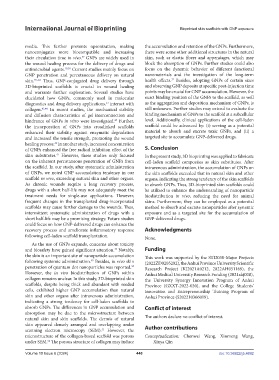Page 448 - IJB-10-6
P. 448
International Journal of Bioprinting Bioprinted skin scaffolds with GNP exposure
media. This further prevents opsonization, making the accumulation and retention of the GNPs. Furthermore,
nanoconjugates more biocompatible and increasing there were some other additional structures in the natural
their circulation time in vivo. GNPs are widely used in skin, such as elastic fibers and appendages, which may
37
the wound healing process for the delivery of drugs and block the absorption of GNPs. Further studies could also
antimicrobial agents. 18,38 Current studies mainly focus on focus on the dynamic behavior of different functional
GNP penetration and percutaneous delivery on natural nanomaterials and the investigation of the long-term
37
skin. 39–42 Thus, GNP-conjugated drug delivery through health effects. Besides, adopting GNPs of certain sizes
3D-bioprinted scaffolds is crucial in wound healing and observing GNP deposits at specific post-injection time
and warrants further exploration. Several studies have points may be crucial for GNP accumulation. However, the
elucidated how GNPs, commonly used in molecular exact binding position of the GNPs to the scaffold, as well
diagnostics and drug delivery applications, interact with as the aggregation and deposition mechanism of GNPs, is
13
collagen. 43,44 In recent studies, the mechanical stability still unknown. Further studies may extend to evaluate the
and diffusion characteristics of gel interconnection and binding mechanism of GNPs to the scaffold at a subcellular
hindrance of GNPs in vitro were investigated. Further, level. Additionally, clinical applications of the cell-laden
45
the incorporation of GNPs into crosslinked scaffolds scaffold could be advanced by: (i) serving as a potential
enhanced their stability against enzymatic degradation material to absorb and excrete toxic GNPs, and (ii) a
and increased the tensile strength, promoting the wound targeted site to accumulate GNP-delivered drugs.
healing process. In another study, increased concentration
46
of GNPs enhanced the free radical inhibition effect of the 5. Conclusion
skin substitutes. However, these studies only focused In the present study, 3D bioprinting was applied to fabricate
47
on the inherent percutaneous penetration of GNPs from cell-laden scaffold composites as skin substitutes. After
the scaffold. In our study, after systematic administration intravenous administration, the accumulation of GNPs on
of GNPs, we noted GNP accumulation tendency in our the skin scaffolds exceeded that in natural skin and other
scaffold in vivo, exceeding natural skin and other organs. organs, indicating the strong tendency of the skin scaffolds
As chronic wounds require a long recovery process, to absorb GNPs. Thus, 3D-bioprinted skin scaffolds could
drugs with a short half-life may not adequately meet the be utilized to enhance the understanding of nanoparticle
treatment needs for single-use applications. However, biodistribution in vivo, reducing the need for animal
frequent changes in the transplanted drug-incorporated skins. Furthermore, they can be employed as a potential
scaffolds may cause further damage to the wounds. Thus, method to absorb and excrete nanoparticles after systemic
intermittent systematic administration of drugs with a exposure and as a targeted site for the accumulation of
short half-life may be a promising strategy. Future studies GNP-delivered drugs.
could focus on how GNP-delivered drugs can enhance the
recovery process and ameliorate inflammatory response Acknowledgments
following cell-laden scaffold transplantation. None.
As the use of GNPs expands, concerns about toxicity
and biosafety have gained significant attention. Notably, Funding
48
the skin is an important site of nanoparticle accumulation This work was supported by the STI2030-Major Projects
following systemic administration. Besides, in vivo skin (2022ZD0205202), the Anhui Province University Scientific
49
penetration of quantum dot nanoparticles was reported. Research Project (KJ2021A0212, 2022AH051169), the
50
However, the in vivo biodistribution of GNPs within Anhui Medical University Research Funding (2021xkj008),
collagen remains unclear. In this study, 3D-bioprinted skin the University Synergy Innovation Program of Anhui
scaffolds, despite being thick and abundant with seeded Province (GXXT-2022-030), and the College Students’
cells, exhibited higher GNP accumulation than natural Innovation and Entrepreneurship Training Program of
skin and other organs after intravenous administration, Anhui Province (S202210366019).
indicating a strong tendency for cell-laden scaffolds to
absorb GNPs. The differences in GNP accumulation and Conflict of interest
absorption may be due to the microstructure between
natural skin and skin scaffolds. The dermis of natural The authors declare no conflict of interest.
skin appeared densely arranged and overlapping under
scanning electron microscopy (SEM). However, the Author contributions
51
microstructure of the collagen-based scaffold was porous Conceptualization: Chenwei Wang, Xinmeng Wang,
under SEM. The porous structure of collagen may induce Xinya Qin
52
Volume 10 Issue 6 (2024) 440 doi: 10.36922/ijb.4692

